The flags of the Australian states all bear the Union Jack on a dark blue background and each is distinguished by a state badge. These flags were created between 1870 and 1904. The territory flags were introduced more recently.
The flags of the states, or colonies as they were before federation, were first flown on the various colonial governments’ ships. By the Colonial Naval Defence Act 1865, the colonies were authorised to fly their own flag on their ships – this was the British blue ensign with the badge of the colony in the fly (portion of the flag furthest from the staff). Designs for the badges were sent to the British Admiralty for approval.
New South Wales
The first badge of New South Wales, authorised in 1869, was simply the red cross of St George on a white field. The current badge on the New South Wales flag has been used on the flag since 1876, and was proclaimed in the New South Wales Gazette on 18 February 1876. It shows a gold lion of England in the centre of the red cross of St George on a white background.
The cross also bears four eight-pointed stars, one on each arm. The stars represent the Southern Cross, and the gold lion and St George Cross reflect the British heritage of the first European settlers. The St George Cross is also the traditional badge of the British Royal Navy.
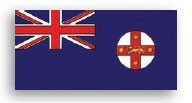
NEW SOUTH WALES
Victoria
The Victorian flag was proclaimed by the Governor in 1870. The first reported flying of the flag was on one of the colony’s first warships, HMVS Nelson.
The badge on that flag comprised the five stars of the Southern Cross.
From 12 November 1877 the badge was changed to include an imperial crown above the Southern Cross. In 1901, with the accession of Edward VII, this crown was replaced with the crown of St Edward, and the flag has not changed since. The Southern Cross stars on Victoria’s state flag differ from those on the Australian National Flag. The stars of the Southern Cross on Victoria’s flag have differing numbers of points, to show their varying brightness.
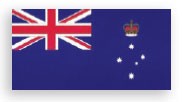
VICTORIA
Queensland
The badge of Queensland’s state flag is made up of the crown of St Edward in the centre of a light blue Maltese Cross. The flag dates back to 1876, when the British Admiralty approved a design submitted by the Governor of Queensland.
Its adoption was notified in the Queensland Government Gazette of 20 November 1876. The first design considered for the badge included a depiction of Queen Victoria’s head, facing right. The Queensland Government considered, however, that this would be too difficult to reproduce well on a flag and an alternative design was proposed.

QUEENSLAND
South Australia
The South Australian state flag was proclaimed on 13 January 1904. Its badge shows an Australian piping shrike (white-backed magpie) on the branch of a gum tree, set against a golden background representing the rising sun.
Originally, the state flag was meant to be flown only from government buildings and vessels, but in 1908 the government of the day encouraged wider use by both government institutions and private citizens.
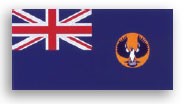
SOUTH AUSTRALIA
Western Australia
The state badge of Western Australia depicts a black swan on a circle of yellow. The black swan has been used as a symbol in Western Australia since the 1830s: the colony was commonly called the Swan River Colony in the early days of settlement. The black swan badge was proposed for adoption in 1870 and its use on the flag was confirmed in 1875.
Originally facing away from the flagpole, the swan was reversed in 1953.
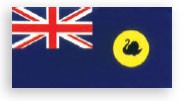
WESTERN AUSTRALIA
Tasmania
On 25 September 1876, the Governor of Tasmania decreed that the distinguishing flag for vessels employed by the Government of Tasmania would be the blue ensign with a red lion superimposed on a white shield. This ratified a proclamation made by Queen Victoria on 7 August 1869.
The flag was subsequently adopted for general state government use, but it was not until 3 December 1975 that the design was gazetted.

TASMANIA
The Australian Capital Territory
The Australian Capital Territory flag was adopted by the territory’s Legislative Assembly on 25 March 1993, after a public selection process.
Blue and gold are the regional colours. The blue and white swans symbolise Aboriginal and European Australians. The castle alludes to Australia’s capital city, Canberra, and the royal crown (the crown of St Edward) represents the role of the Sovereign in government. The sword of justice, the parliamentary mace and the rose of York are depicted on the shield.
From 1927 until this new design became the official flag of the Australian Capital Territory, the city of Canberra’s flag had been used as a de facto flag. This flag features the full coat of arms of Canberra, including the swans as supporters.
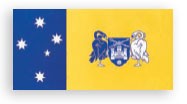
AUSTRALIAN CAPITAL TERRITORY
The Northern Territory
The Northern Territory flag was adopted on 1 July 1978, when self-government was proclaimed.
Mr Robert Ingpen, a prominent Australian artist, was commissioned to design the flag. He based his design on a number of designs entered in a competition organised by the Northern Territory Government in 1978.
A black panel on the left of the flag bears the Southern Cross. On the right-hand ochre-coloured panel is a stylised Sturt’s desert rose in white with a black star in the centre. The seven petals of the desert rose and the seven points of the star symbolise the six Australian states and the Northern Territory.
The Southern Cross stars, in white, have the same number of points as on the Victorian state flag. Black, white and ochre are the official colours of the Northern Territory and the Sturt’s desert rose is its floral emblem.
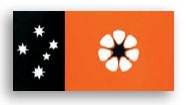
NORTHERN TERRITORY
The external territories
Australia has seven external territories: Norfolk Island, Heard Island and McDonald Islands, Christmas Island, the Cocos (Keeling) Islands, the Australian Antarctic Territory, the Coral Sea Islands, and Ashmore and Cartier Islands.
Norfolk Island is the only external territory with its own official flag. Adopted on 11 January 1980, this flag has three vertical panels: the outer two are deep green, while the central panel is white and bears a deep green Norfolk Island pine.
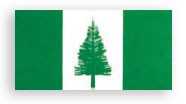
NORFOLK ISLAND
Christmas Island and the Cocos (Keeling) Islands have flags that are used in the community but have not been formally adopted.
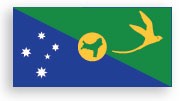
CHRISTMAS ISLAND

COCOS (KEELING) ISLANDS
The Australian National Flag is flown at all Australian bases in the Australian Antarctic Territory. It is also flown with the flags of other Antarctic Treaty nations at the South Pole.
Jervis Bay
Jervis Bay, the only Australian internal territory without self-government, does not have its own flag.
